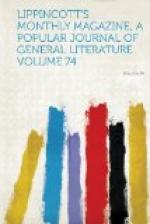We have a beautiful collection at the Art Museum in Fourteenth street of jewelry, objets d’art, and a good ceramic display, all clustered round the Di Cesnola sculptures and pottery. This collection, founded on the idea of the South Kensington Museum, makes a most agreeable lounging-place in the Kruger mansion, and is, in the absence of most of the opulent owners of private picture-galleries and the closing of the National Academy, almost our only artistic amusement at present. But the first of December will throw open many hospitable doors, and the new pictures and statues which have been accumulated during the past summer will become in one sense the property of the gazing public.
MARGARET CLAYSON.
NOTES.
Amongst the traditional scenes of the drama probably none plays a part more useful than the village festival. This merrymaking appears twice or thrice in an ordinary pantomime, regularly adorns the melodrama, is almost an essential of the opera, could not be dispensed with in the plays of the Fanchon type, and may even relieve the sombre tints of dire tragedy. We all know the charming spectacle: peasant youths and maidens, clad in all the wealth of the dramatic wardrobe, are skipping around a Maypole; presently Baptiste and Lisette are discovered kissing behind a pasteboard hedge, and are drawn out with universal laughing, in the midst of which enters the recruiting-sergeant with his squad and whisks off poor Baptiste to the wars. It is a pleasing scene—a trifle monotonous now with repetition; and for this latter reason it might be well to vary it by substituting the rural Feast of the Onion, which a ’correspondent of the Cambrai Gazette witnessed in the suburbs of Gouzeaucourt. Every year, between June 24th and July 2d, the inhabitants of the two neighboring villages of Gouzeaucourt and Gonnelieu perform the ceremony of “turning the onion”—that is to say, they dance in a circle, joining hands, on the village green of one or the other hamlet. Thanks to this ancient custom, the two French communes raise the finest onions in the department, this vegetable never failing, as carrots are apt to do in that locality: on the contrary, the onions are well-grown, finely rounded, and in short, magnificently “turned.” On this festive occasion three or four hundred persons of every age and condition dance around a well in Sunday best, rigged out in ribbons and with smiling faces. The more they hop the bigger the crop of onions; and naturally they skip and sing till out of breath, always repeating the popular song, “Ah! qu’il est malaise d’etre amoureux et sage.” Surely, all this would form a pleasant variety on the ordinary festal scene of the stage; and we hasten to remind the fastidious that though this ceremony is the Feast of Onions, yet it does not appear that that odorous esculent need actually be present; besides, even if it were, surely a garland of “well-turned”




